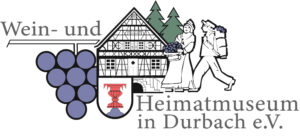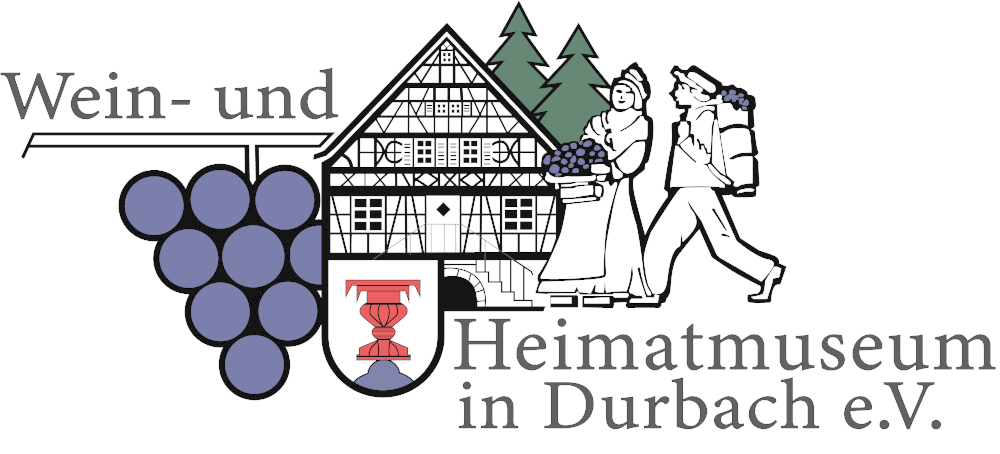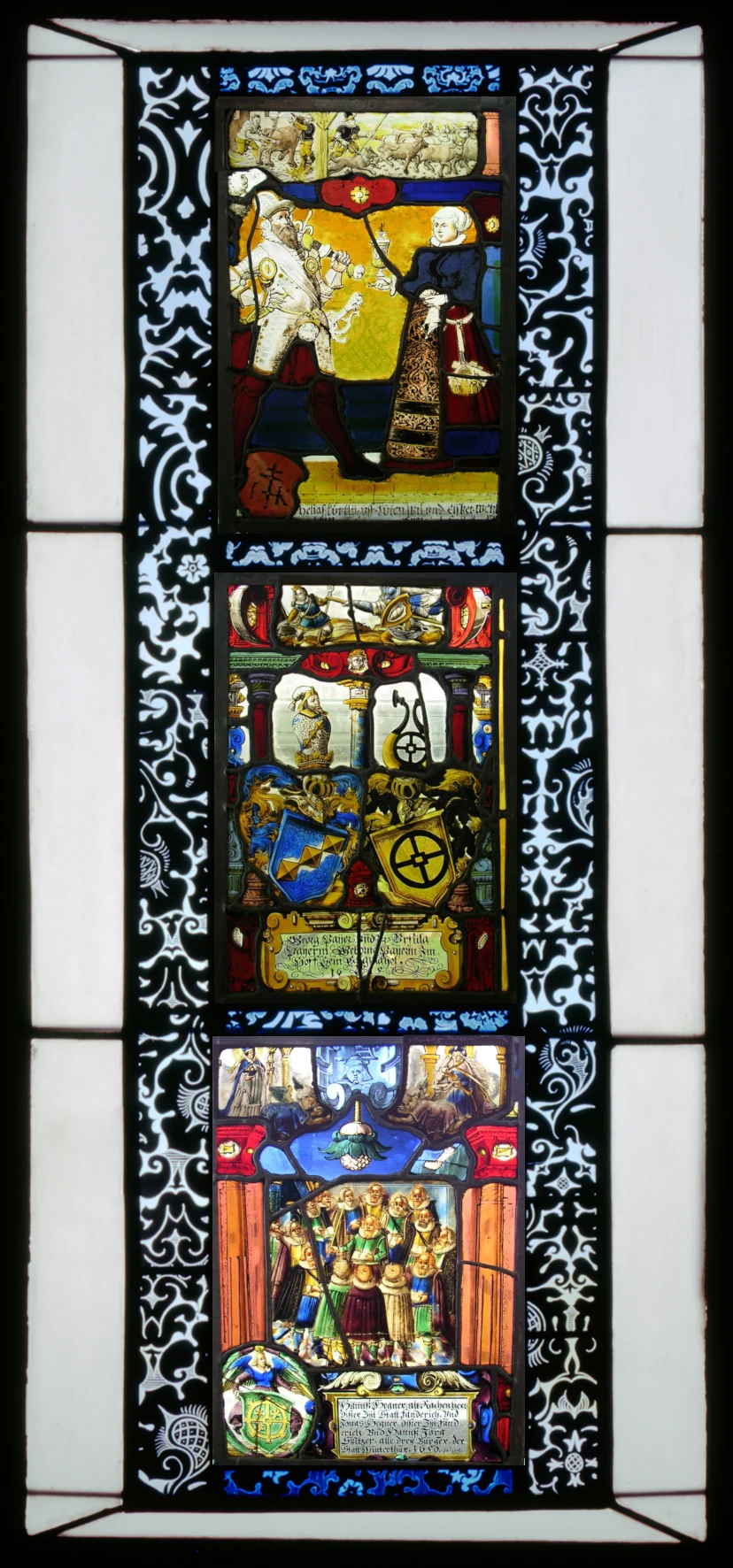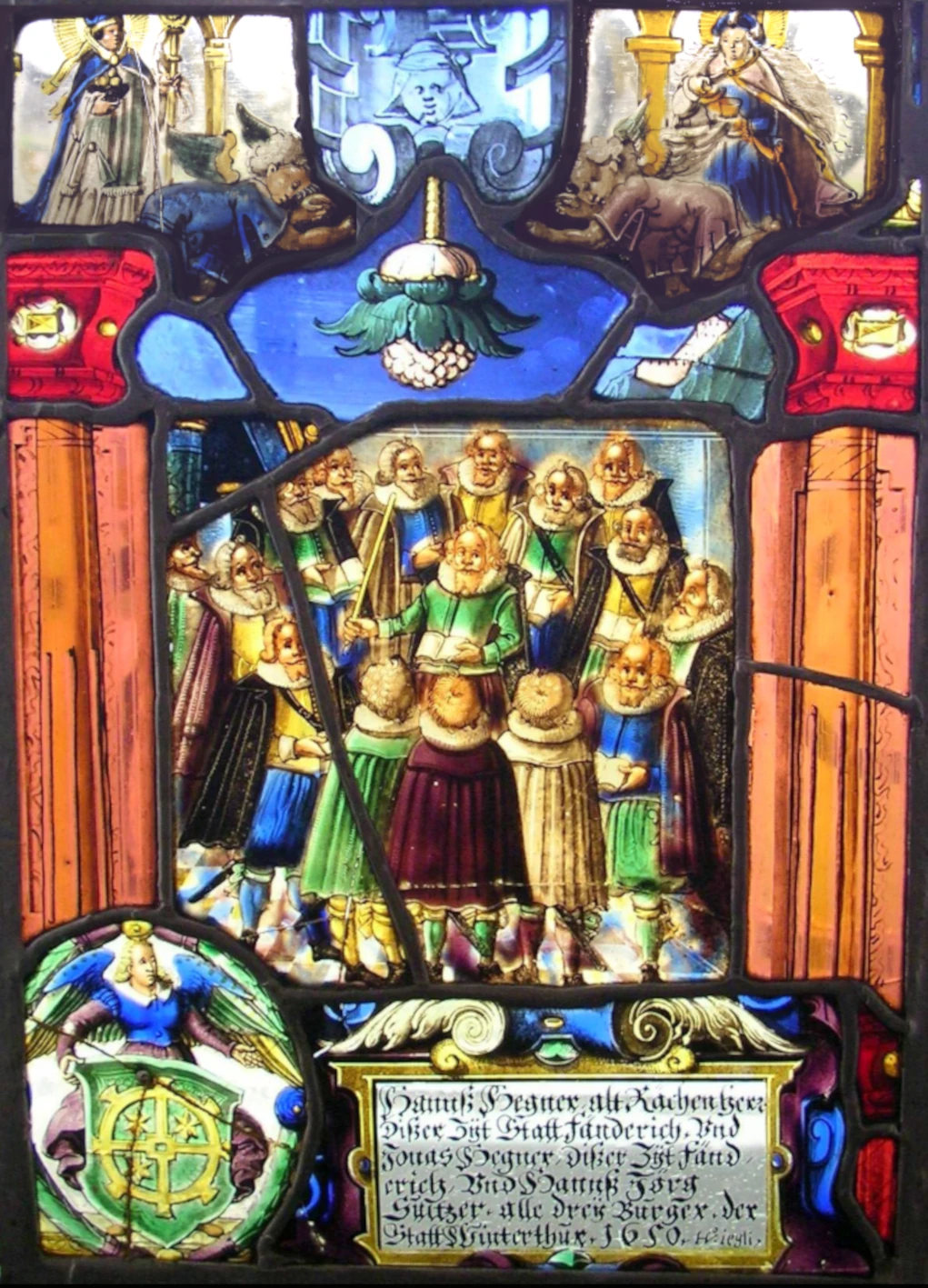269 Staufenberg Castle Window 9
Motif above: Man in armour with a two-handed sword on his shoulder, woman in 16th century costume with a goblet. House coat of arms in red shield. Headpiece: Burning of bulls and cattle drive with dog, year 1598. Inscription: “Helias Kürtly uff Lutenwis und Elsbet Wetzler sin …1598” (it should read correctly: “Helias Kuratli uff Lutenwil”)
Motif centre: Alliance coat of arms disc Georg Peyer with the Wecken and Ursula Peyer in the courtyard. Georg Peyer was a member of the Society of Merchants, town judge and grand councillor in Schaffhausen. He married Ursula Peyer in the courtyard in 1612. Headpiece: David against Goliath. Probably made in 1615 by Hans Caspar Lang the Elder from Schaffhausen. Inscription: “Georg Payer and Ursula Payerin born Payerin Jm- Hoff Sein Ehg..ahel 16.9″
Motif below:The singing school of the city of Winterthur, founded in 1629. The headpiece depicts St Nicholas on the left and St Barbara on the right. The disc donors listed were craftsmen and merchants and part of Winterthur’s urban upper class. Inscription: “Hannß Hegner, alt Rächenherz, dißer Zyt Statt Fänderich, Und Jonas Hegner Dißer Zyt Fänderich und Hannß Jörg Sultzer . alle drey Burger der Statt Winterthur . 1650 H. iegli”
Motif above: According to the church register of the Protestant parish of Nesslau, which begins in 1582, Elias Cunratli’s first marriage was to a Verena, from whom he had a daughter Ursula in 1583 and a son David in 1584, who was the godfather of Amann Davit Tobler. On 25 March 1595 Elias Cunratlin married Elßbeth Wetzleri, who bore him four children by 1606. Elias Curetli Amann is named in the last baptismal entry on 4 April 1606, and this Staufenberg disc is described as follows in Paul Bösch’s description of “Toggenburger Wappenscheiben” from 1935:
Man with armour and sword, woman with cup. Upper picture: Herd of cattle. On simple banner, destroyed at the lower edge and partly illegible: Helias – kurtly uff – Lutenwil und Elsbet Wetzleri sin …
Hans Jegli (Jäggli, 1579 – 1643) made a whole series of similar armorial discs for wealthy Toggenburg farmers. These are known as “welcome discs” … the wife hands a drinking goblet to the husband returning from war. A peasant allegory is then placed at the top. Lutenwil lies in the upper Toggenburg SG, near Nesslau. (above Nesslau (therefore “uff Lutenwil“)
The coat of arms disc next to the inscription contains a cross and the letters E + K, which probably refers to the donor of the disc.
Motif centre: Alliance coat of arms. In a blue shield three golden lozenges, a helmet jewel, the upper part of a man with cap and lozenge band, in a golden shield a black wheel, the same between two horns as a jewel; the coats of arms framed by Renaissance architecture.
The coat of arms shows the connection/alliance of two well-known burgher families from Stadtschaffhausen (Peyer with the Wecken and Peyer im Hof).
The disc donor Georg Peyer (1586-1648), son of the merchant David Peyer (1549-1613) and Sabina Zollikofer (1554-1626) from St. Gallen, was a member of the Society of Merchants, town judge and grand councillor. On 16 November 1612, he married Ursula Peyer Im Hof (1593-1665), the daughter of Hans Ulrich Peyer im Hof (1551-1600), the son of Bernhardt the Younger. Their marriage produced Sabina (1614-1683), David (1616-1653), Ursula (1619-1663) and Barbara (1629-1652), as well as several children who died young.
Georg Peyer, who lived in the property “Zum Trauben” at Vordergasse 47, his mother’s house, had assets totalling 65,460 guilders in 1640 and was therefore very wealthy. Peyer’s wealth was also due to his estates and the loans and trading business he conducted. Together with his younger brother Hans Andreas, he founded a company trading in copper, cheese, grain and other goods, which had connections as far afield as Geneva, Lyon, Besançon and Nuremberg.
Georg Peyer commissioned larger glass paintings, whereby the pane from Staufenberg Castle was probably made by Hans Caspar Lang the Elder in 1615.
Literature reference: Rolf Hasler „Die Schaffhauser Glasmalerei des 16. bis 18. Jahrhunderts
Motif below: Founded in 1629, the Musikkollegium Winterthur initially performed mainly as a choir and accompanied the church service. The coat of arms and the lettering with the names, which can be seen in the lower part of the disc, were probably added later. However, the donors could be traced as follows:
Hans Hegner, old arithmetician, town ensign 1595-1668, grand councillor, hospital clerk, master marksman, petty councillor, curator of St George’s Church, head curator at the hospital, money counter (indirect tax on drinks), hospital master, co-founder of the town library in 1660 (donated his own books), middle Marktgasse north side, married with three children and a maid.
Jonas/Jonathan Hegner, ensign 1576-?, churchwarden, woodworker, tanner, lower Marktgasse south side; married, six children, an apprentice and a maid.
Hans Jörg Sulzer 1594-1659, shoemaker, Eulachschauer (supervisor of the river), church warden, Grand Councillor from 1655
Hans Ulrich Jegli (or Jäggli) from Winterthur (*1604 + 1654), whose father was also a glass painter, is probably known to have painted the glass.





